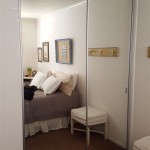What Is Enable Mirror Effect on Zoom?
The "Mirror my video" setting in Zoom refers to how one's own video feed appears to oneself during a meeting. Enabling this setting displays the self-view as if looking into a mirror. Movements appear reversed; raising the right hand appears as raising the left hand in the self-view. Disabling this setting presents the self-view as others in the meeting see it, with movements corresponding to reality. This can be likened to seeing oneself on a recorded video playback.
This setting does not affect how other participants see the user's video. Their view remains consistent regardless of the mirroring setting. The setting is purely for the user's self-perception during the meeting.
The mirroring effect can be particularly helpful for tasks involving physical demonstrations or presentations. For example, if presenting materials or pointing to something on screen, mirroring enables users to instinctively reach in the correct direction from their perspective. Without mirroring, aligning physical movements with the on-screen content can require more conscious effort and potentially appear awkward or disorienting.
Conversely, some users prefer to disable the mirroring effect for a more accurate representation of their appearance to others. This can be beneficial for activities like on-camera presentations where maintaining eye contact and natural body language is important. Viewing oneself as others do provides a more direct and realistic sense of how these non-verbal cues are being conveyed.
The preference for mirroring is subjective and depends on individual comfort and the specific context of the Zoom meeting. Users may find it helpful to experiment with both settings to determine which provides a more natural and effective communication experience.
Enabling or disabling the mirroring effect is a simple process within the Zoom application settings. Prior to joining a meeting, users can access their video settings. Within this menu, a checkbox or toggle labeled "Mirror my video" allows users to control the setting.
Even during an active meeting, adjustments can be made. By clicking on the video thumbnail and selecting the "Video Settings" option, users can access the same mirroring control and modify the setting in real-time without disrupting the meeting flow.
The default setting for Zoom's mirroring feature is typically enabled. This means that upon initial installation and use, most users will experience the mirrored view of themselves. However, this default can be changed permanently within the application settings to reflect individual preference.
Understanding the distinction between how the mirroring setting affects self-view versus the view of other participants is crucial. The setting provides control over personal visual feedback without altering how the video feed is broadcast to others. This allows for individual customization without impacting the meeting experience for other participants.
Beyond the practical considerations of presentations and on-screen interactions, the mirroring effect can also impact the psychological experience of video conferencing. Some users report feeling more comfortable and less self-conscious with mirroring enabled, finding the mirrored view more familiar and less distracting.
Others, however, may find the mirrored view disorienting, particularly during extended periods of on-screen interaction. In these cases, disabling the mirroring can create a more grounded and realistic sense of presence within the virtual meeting space.
Zoom's flexibility to easily toggle this setting allows users to adapt their experience according to individual preferences and the specific demands of each meeting. Experimentation and awareness of the setting's impact are key to optimizing the video conferencing experience.
The "Mirror my video" setting is a subtle yet impactful feature within Zoom that often goes unnoticed. Understanding its function and how it affects the self-view can significantly improve the overall user experience, facilitating smoother on-screen interactions and promoting more effective communication within virtual meetings.
The setting's availability both pre-meeting and in real-time offers a level of control and adaptability that caters to diverse user needs and preferences. This attention to detail contributes to Zoom's user-friendliness and its effectiveness as a platform for virtual communication.
While the mirror effect primarily influences the individual user experience, its impact on presentation quality and non-verbal communication can indirectly affect the overall effectiveness of the meeting for all participants. Therefore, awareness and appropriate use of this feature can contribute to more engaging and productive virtual interactions.
By providing a simple toggle for this function, Zoom acknowledges the individual variability in user preferences and empowers users to optimize their experience for maximum comfort and effectiveness.
The "Mirror my video" feature, though simple in its implementation, exemplifies Zoom's commitment to providing a user-centric platform that prioritizes individual control and adaptability in the virtual meeting space.
How To Reverse The Mirroring Effect In Zoom Free Technology For Teachers

Zoom S Tips Secret Tools To Enhance Your Meetings

Easy Steps To Mirror My On Zoom
Zoom Filter Makes You Look Better During Work From Home Conference Calls

Mirror On Zoom Fixed Flip Problem

Easy Steps To Mirror My On Zoom

The Ultimate Manual To Zoom Filters

Images Show In Reverse Or Upside Down Windows 11 10

What Is Mirror My On Zoom How It Works And Should You Enable

Zoom Enable Mirror Effect








